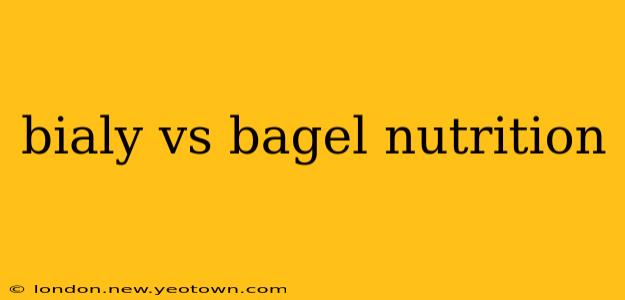Bialy vs. Bagel: A Nutritional Showdown
The aroma of freshly baked bread, the satisfying chew – bagels and bialys both offer a delicious start to the day or a comforting snack. But when it comes to nutrition, how do these two similar yet distinct breads stack up? Let's delve into a delicious comparison, exploring the subtle differences that can significantly impact your health choices.
Imagine this: you’re at your local bakery, faced with a delectable dilemma. A perfectly golden bagel, glistening with a sesame seed sprinkle, beckons from one side. On the other, a bialy, its subtly indented center hinting at a softer, more delicate texture, calls to you. Which one do you choose? Understanding the nutritional nuances can help you make an informed decision.
What's the Difference Between a Bialy and a Bagel?
Before we dive into the numbers, let's establish the core differences. Bagels are known for their ring shape and chewy texture, often boiled before baking, which gives them a unique, slightly dense character. Bialys, originating from Bialystok, Poland, are flatter, round rolls with a distinctive depression in the center, often filled with onions or poppy seeds. They typically lack the characteristic boil-before-bake process of bagels, resulting in a softer, less dense interior.
Nutritional Breakdown: Bialy vs. Bagel
A direct comparison of nutritional content depends heavily on size and ingredients. However, general trends emerge:
-
Calories: Bagels typically contain slightly more calories than bialys, often due to their larger size and denser structure. However, this can vary widely depending on the specific recipe and additions like seeds or toppings.
-
Carbohydrates: Both are primarily carbohydrate sources, providing energy. However, bagels might have slightly more carbohydrates overall due to their size.
-
Fiber: Fiber content can be surprisingly similar, depending on the ingredients. Whole-wheat versions of both will naturally be higher in fiber.
-
Protein: Protein content is generally low in both bagels and bialys, but a larger bagel might offer marginally more.
-
Fat: Fat content varies drastically based on toppings and added ingredients. A plain bagel or bialy is relatively low in fat. Cream cheese, butter, or other additions dramatically increase the fat content.
How Many Calories are in a Bialy vs. Bagel?
The calorie count differs greatly based on the type and size. A small plain bialy might contain around 150-200 calories, while a larger, everything bagel can easily exceed 300 calories. The addition of toppings like cream cheese significantly increases the calorie count in both instances.
Which is Healthier: Bialy or Bagel?
There isn't a clear-cut "healthier" option. The nutritional value depends heavily on the ingredients and portion size. A whole-wheat bialy with a modest topping is likely a healthier choice than a large, sugary bagel loaded with cream cheese.
Are Bialys Better for Weight Loss Than Bagels?
Neither is inherently better for weight loss. Portion control and overall dietary choices are paramount. Choosing a smaller, whole-grain option of either is a wiser strategy for weight management than indulging in a large, refined-grain version loaded with fat and sugar.
What are the Health Benefits of Eating Bialys and Bagels (in moderation)?
Both bagels and bialys can offer some health benefits in moderation. Whole-grain varieties contribute fiber, which aids digestion and promotes satiety. However, overconsumption of either can contribute to weight gain and other health issues.
Ultimately, the "better" choice comes down to mindful selection. Opt for whole-grain options whenever possible, control your portion sizes, and be aware of added toppings. Enjoy your bread, but do so consciously!

